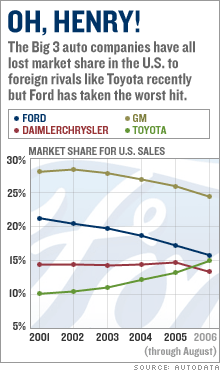|
Ford's deep cuts not deep enough Experts question whether moves to slash capacity and staff, and to develop new vehicles are enough to right the troubled automaker. NEW YORK (CNNMoney.com) -- Imagine reaching an agreement that could conceivably eliminate all your well-paid union workers and setting a sales target about 40 percent below your market share of a decade ago, only to be told by Wall Street that you're not cutting deep enough. That's what happened to Ford Motor Co. (Charts) Friday.
The company announced wide-reaching changes, including speeding up and expanding plant closing plans announced less than a year ago. It also made an agreement with the United Auto Workers union, offering to make payments of up to $140,000 to any of its 75,000 U.S. hourly employees who are willing to leave the company. In addition, it set a sales target of only 14 percent to 15 percent of total U.S. vehicle sales, down from the 25 percent share it held as recently as 1997. That will put it behind Toyota Motor Corp. (Charts) here in its home market, giving up the No. 2 position it held longer than the country has had interstate highways, let alone Japanese imports. But analysts, experts and the market itself were less than impressed. Some had wanted the company to sell off other money-losing divisions, such as Jaguar, or cut even deeper into its plant and employee base. Others simply suggested that the announced changes would not be enough. "It's missing a lot," said a note from John Murphy, auto analyst for Merrill Lynch, as he downgraded the company to a "sell" from a "neutral rating." "The plan does not address the tremendous losses at Jaguar or asset sales," he wrote in a note to clients. "It does not materially accelerate product introductions. It does not provide a solution for the troubled facilities assumed from Visteon (Charts). It does not cut capacity deeper." The market viewed the Ford announcement much the same way as shares plunged nearly 15 percent to their lows of the day before rebounding slightly. The problem, according to other experts, is that while Ford's forecasts for its reduced market share might still be overly optimistic. "Detroit, in general, is not nimble enough to adjust to rapid changes in the markets," John Casesa, managing partner Casesa Strategic Advisors, told CNN Friday. "Two long-term problems that have simmered in the industry -- that is very high labor costs and having the wrong product -- are boiling over." For example, Ford is committed to building a new line of SUV-like vehicles with a more car-like ride, known as crossovers, as well as a new generation of its best-selling F-150 pickup. But its executives said the company could not commit to developing a new line of fuel-efficient sub-compact cars, even as fuel prices have led buyers to take a renewed interest in fuel economy, and all its major competitors prepare to focus on that segment of the market. "It's a question of priorities, a question of resources," said Mark Fields, Ford's president of the Americas. Even if Ford does well with the new models its executives promised Friday, it will be very difficult for the company to regain the ground it has lost. "They have to convince the satisfied Toyota, Honda and Hyundai customers to come back," Casesa said. "It's going to be a multi-year process." Ford promised Friday that the new redesign of the F-150 pickup, still the nation's best-selling vehicle model, will be unlike anything else seen in the market when it hits showrooms in late 2008. But between now and then, Ford will be faced with a new line of full-size pickups from General Motors (Charts) that will start hitting showrooms this fall, as well as Toyota's first entry into the full-size market early next year with its redesigned Tundra. The version of the F-150 that last saw a significant redesign was the 2004 that first hit showrooms in 2003. While another redesign after only five years is a quicker than normal turnaround time, it does show the problems Ford is having responding to the rapidly changing market. "What should be scary for them is that they are putting out better and better products, and they're still losing market share," said Kevin Tynan an auto analyst with Argus Research. "We have more brands, more competition, every model year. They're still hoping for 900,000 F-series pickups and 400,000 Explorers when that's not where this market is going." For many observers, the moves announced Friday are simply a prologue to the real significant changes that will have to come in September 2007, when the current labor agreements between the UAW and GM, Ford and DaimlerChrysler's (Charts) Chrysler unit are all set to expire. Some experts are hopeful the traditional Big Three will get the changes they need to compete with imports such as Toyota, Honda (Charts) and Nissan, which are busy expanding their own North American manufacturing capacity and market share. "The root causes of these problems, whether product, or labor or management, all these things need to change because it's that or Chapter 11 (bankruptcy filing)," said Casesa. "I don't think the UAW, or the Ford family or the shareholders of GM would find chapter 11 an acceptable alternative." ________________________________ |
|

